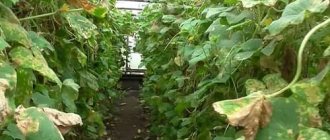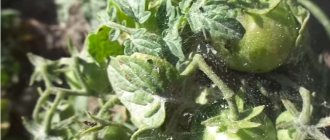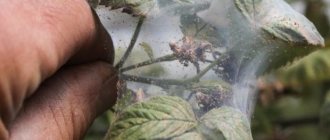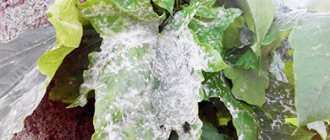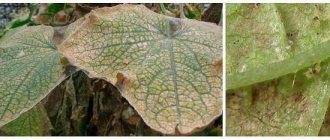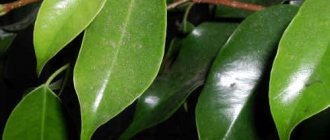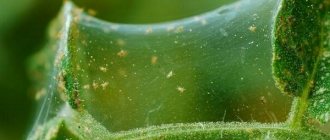Mistakes in care, improper preparation of berry plants for winter, and favorable climatic conditions contribute to the appearance of spider mites on strawberries, which are often called strawberry mites. Despite its microscopic size, the pest is very insidious. Creatures invisible to the naked eye meticulously suck the juices out of plants, which leads to their drying out and even death. How to deal with spider mites on strawberries is determined by the degree of damage, the size of the plantations, and the personal preferences of the gardener.
Spider mite
The spider mite is a microscopic creature (the maximum size of the pest does not exceed 1 millimeter), whose body has a scarlet, light green or yellowish tint. (Photo) The oval body of the parasite is covered with small bristles, the legs are equipped with suction cups, thanks to which the mite is firmly attached to the plant. The mouthparts are able to pierce even fairly hard leaves and suck out the juice from them.
The life cycle of a male does not exceed several weeks, females can spend up to six months in diapause (after wintering they have a brown color), and spider mite eggs remain viable for several years. The female tick is capable of withstanding quite severe frosts during diapause, so she can easily survive the winter in mid-latitudes, hiding in the upper layers of the soil, old foliage or in greenhouses. It should be understood that this description of the spider mite is not exhaustive, because today about 1,300 species of insects have been described, about 100 of them live in mid-latitudes. The pest poses a threat to most vegetable crops. It also affects garden trees (cherry, apple) and berries: strawberries, black currants, gooseberries, raspberries, grapes.
Description of the pest
Garden strawberries are affected mainly by 2 types of mites: strawberry mites (Phytonemus pallidus), sometimes called cyclamen mites by florists, and the common spider mite (Tetranychus urticae). Fighting the latter is not much of a problem. Both specific acaricides and insectoacaricides from the organophosphorus group cope with it. The fight against strawberry is more complex, so the recommendations presented in the article are focused specifically on this type of pest.
The strawberry mite (Phytonemus pallidus) has a flattened, elongated, translucent body. Adults reach a length of about 230 microns. Due to its small size, this arthropod can only be seen through a microscope or a magnifying glass with 10x magnification.
Ticks have enormous fertility with a short period of larval growth. In one strawberry season, about five generations can appear in the beds. The peak of damage occurs at the end of summer. When the temperature drops to +10℃, the tick hides in leaf folds for the winter. Threshold of tangible economic damage from mites: 4-8 mites per leaf.
The tick feeds on plant sap and lives in the central bud—the heart. The youngest unblown leaves are affected.
Among modern varieties, Elsanta strawberry showed excellent resistance to mites
Symptoms of strawberry damage
As we have already noted, the spider mite has a very modest size; it is not always possible to detect it with the naked eye. You should start inspecting the beds in late April - early May: it is during this period that females emerge from hibernation and settle on various plants, preferring weeds. By the beginning of June, the pest moves to strawberries, raspberries, black currants, and other berries and vegetables. During this period, it is necessary to pay maximum attention to inspecting the underside of the leaves - this is where the female spider mite first settles to lay eggs.
The first signs of the presence of a spider mite on strawberries, grapes, strawberries are small white and yellowish spots, indicating that in this place the insect has pierced the leaf and has begun to suck the vital juices from the plant. In some areas, leaves may become discolored, curled, and yellow. If you look closely, you will be able to detect small cobwebs that connect individual leaves and entwining rosettes. The appearance of a cobweb indicates that the mite is numerous; if no action is taken during this period, you can lose a significant part, or even the entire crop.
Signs of appearance
You can determine that there is a strawberry mite in the area by looking at the condition of the plants. There are much fewer bushes compared to last season. Full size leaves are observed only in some plants. In addition to a sharp decrease in yield, the following symptoms of mite infestation are noted:
- wrinkled leaf blades;
- poorly developed rosettes of bushes;
- yellowness of leaves;
- the presence of a white coating on the back of the sheet;
- underdeveloped and dried berries, leaves, flowers.
Strawberries damaged by mites may initially produce full berries, but gradually the plant begins to lag in growth. Diseased leaves curl and fall off. Flowers and already formed berries dry out. This leads to the extinction of bushes in summer and autumn, as well as to mass freezing in winter.
Prevention of spider mites on strawberries
There are currently a huge number of different acaricides available that control the pest quite effectively. However, before resorting to radical means in the fight against spider mites, we would advise taking preventive measures that often prevent the appearance of insects in strawberry beds, other berries and garden trees. Prevention must begin in the fall and be carried out throughout the season.
Prevention measures:
- After harvesting, remove all mousse: withered leaves and stems, dead plants and weeds;
- During this period, the soil can be disinfected. Disinfection is best done by sprinkling the ground with bleach (at the rate of 100 grams per square meter), and then digging up the bed;
- If you grow strawberries in a greenhouse, then in the fall you need to clear the soil of weeds and disinfect the soil; We also recommend wiping all surfaces in the greenhouse with an acaricidal solution and disinfecting with sulfur or tobacco smoky bombs; (Photo)
Weevil during flowering
You can protect the future harvest by spraying the plant twice a season: in spring (a week before flowering) and in summer (in July). The following working compositions are used: Fitoverm, Akarin, Iskra-bio.
Sometimes a third treatment is carried out if insects were found in the beds. This can be done with drugs: Anthonem - F, Namabakt.
Among the effective folk methods of fighting the beetle:
- mechanical assembly from bushes;
- planting nearby beds of fragrant herbs (wormwood, tansy, hot pepper);
- treatment with mustard solution (3 liters of water per 100 grams of defect);
- an adhesive mixture based on laundry soap (40 g) and 3 kg of ash.
Folk remedies in the fight against spider mites
If all the preventive measures taken have not brought the desired result, do not rush to run for strong chemicals. Perhaps your strawberries can be saved from spider mites using safe and fairly effective folk remedies. It should be borne in mind that the treatment of strawberries with folk remedies must be carried out several times (2 - 5), otherwise you will not achieve a noticeable effect in the fight against spider mites.
Calendula infusion. As we already mentioned, spider mites cannot tolerate the smell of this plant. To prepare the infusion, take 400 grams of fresh calendula flowers and pour two liters of water over them. The container with the solution should be tightly sealed and left to infuse in a warm place for 5 - 7 days. After this period, strain the infusion on several layers of gauze, add 4 liters of water and 50 grams of liquid or finely ground laundry soap. Stir the liquid until soapy foam appears (this will increase the stickiness of the infusion) and use it to repeatedly spray the strawberries.
Dandelion infusion
Dandelion infusion. Safe, easy to prepare and use remedy for spider mites. It is necessary to pick 400 grams of fresh leaves and add 200 grams of other parts of the plant (stems, roots). The raw material is poured with 10 liters of warm water (water temperature should not exceed 40C) and left for 3 hours. The infusion is filtered through cheesecloth, 100 grams of crushed laundry soap is added and stirred until soap foam appears. It is important to use a fresh infusion, preferably on the day it is prepared.
Onion infusion. Grind 100 grams of onions in a meat grinder or under a press, fill it with warm water and leave to steep for 24 hours. After straining, add 100 grams of liquid or laundry soap and treat the strawberries if they show signs of spider mite damage.
You can use onion peels instead of onions. In this case, you need to take 100-120 grams of onion peel, fill it with five liters of hot water and leave for 100-120 hours. After this, strain the mixture, add soap, stir and use to protect strawberries from spider mites.
Recommendations
- loosen the soil and hill up the bushes; - plant the berries next to the onions and garlic;
- Before planting, treat the seedlings with hot water;
- plant seedlings on a sunny, well-ventilated side;
- alternate methods of processing plants, do not get carried away with just one;
- treat all bushes, even if one plant is affected;
- carry out about three treatments, insect eggs are very resistant;
- try to get rid of the pest in the early stages.
The most important mistake of summer residents is untimely weeding and cleaning of the beds. “Guests” noticed at the wrong time and other problems with plants. To prevent this from happening, regularly monitor your site and care for the seedlings.
Chemical control methods
There are years when neither preventive measures nor folk remedies help cope with spider mites that have affected strawberries. Then, to save the crop, agrochemicals have to be used. Today there is a large selection of chemicals available on the market; when choosing and using them, we recommend that you read the description of the drug and follow basic safety measures.
Fitoverm. A fairly popular and safe insectoacaricide that effectively controls a wide range of harmful insects. Fitoverm is a systemic drug: when exposed externally or internally, it paralyzes the nervous system of the pest, which leads to its immediate death. Mass death of parasites occurs within 6-8 hours, the period of protective action can reach 15 days or more, depending on weather conditions. The advantages of the chemical include its low resistance and the fact that it does not accumulate in fruits and soil.
Alatar. Another popular and very effective drug for protecting strawberries from spider mites and other pests. The chemical is based on two active ingredients: malathion and cypermethrin. When these substances come into contact with the skin or inside a tick, they affect the nervous system of the insect; the product effectively destroys not only adult ticks, but also eggs and larvae of the pest. Alatar has a fairly long period of protective action: 15 – 20 days, depending on weather conditions. Important - you cannot spray plants more than once a season.
Fitoverm Alatar
Bitoxibacillin
Envidor. An innovative acaricide from the German company Bayer is designed to combat a wide range of pests; it effectively controls spider mites at all stages of their development. The drug is characterized by high adhesion, it does not cause addiction to insects and does not accumulate in the soil and fruits. Envidor demonstrates high effectiveness at all stages of plant development, but the manufacturer recommends using it at a time when the mite population on strawberries has not reached its maximum level. The chemical belongs to the second class of toxicity; when working with it, we recommend wearing a mask, goggles and gloves.
Bitoxibacillin. A very effective and safe drug used to protect plants from spider mites and other types of harmful insects. The advantages of the biological product include its low toxicity (it is not dangerous for people, warm-blooded animals, bees and other beneficial insects), as well as the fact that it does not accumulate in fruits and soil. According to reviews from gardeners, Bitoxibacillin is not addictive to mites; it can be used to process strawberries for several years in a row.
Getting rid of parasites
Dealing with the pest is not that difficult, so if you find one on your property, don’t panic. The main thing is to choose the appropriate method of combating strawberry mites and follow it until the insects disappear.
Use of chemicals
This method of killing harmful insects is quite effective. It consists of treating strawberry bushes with special chemicals. There are many drugs that can cope with ticks. Among them are:
- Karbofos. It is a moderately toxic product that, in addition to ticks, also destroys other garden pests. It is recommended to treat strawberries with it at least 2 times during the season. It is best to do this in dry, windless weather at a temperature not lower than + 15 degrees in the morning or evening. The drug should be diluted in accordance with the attached instructions. You need to spray both the outer and inner surfaces of the leaf plate. It is prohibited to use karbofos during flowering.
- Colloidal sulfur. Also used against a number of pests. Available in powder and paste form. It is recommended to use the product at temperatures from +20 to +30 degrees. In colder weather, the drug does not guarantee a 100% result, and in temperatures above 30 degrees, burns may appear on the leaves. During the season, twice treatment is required.
- Neoron. It is a contact acaricide, that is, it acts specifically on ticks. Available in ampoules of 5 ml. It is distinguished by the fact that it does not harm bees much. Bushes with strawberries or wild strawberries should be treated with the drug, following the instructions.
- Fitoverm and Akarin. Belong to the group of biological pesticides. This means that when used correctly, they do not harm human health or beneficial insects. They need to be diluted in a proportion of 20 ml per 10 liters of water, and spraying with these products is carried out 3 times every 7 days.
It is possible to use Fufanon, Actellik, Marolex and other chemicals against the pest.
Biological method
It is another measure to combat the strawberry mite and involves the settlement of insects on the affected area, which contribute to the destruction of the pest. This could be Trichogramma, which lays its eggs inside the eggs of the mite, as well as some types of phytophagous mites that eat the strawberry pest.
Such insects can be purchased in specialized stores or biological laboratories. But this tool is not available to everyone and not in all regions.
Agrotechnical techniques
They suggest proper care of strawberry beds, the use of varieties that are resistant to parasites, and the cultivation of plants that repel ticks. So, to rid the area of pests in early spring, you should remove and burn the remains of damaged plants, because this is where the female strawberry mites are located. The remaining strawberry bushes should be thoroughly doused with water heated to 80 degrees. Only after these measures can you begin normal crop care.
As for the choice of varieties, it is better to focus on those species that are resistant to the strawberry mite. These varieties include Zenga-Zengana, Torpedo, Vityaz, Zarya and some others. New types of strawberries appear every year, so before purchasing you should carefully study the information about them.
It will also help to reduce the number of parasites by planting plants next to the strawberry bed that can repel ticks with their smell. Among them are tansy, lavender, catnip, rosemary, and Dolmatian chamomile.
Folk remedies
You can also fight strawberry mites on strawberries using folk remedies. They involve the use of various herbal decoctions and infusions:
- Infusion of onion peels. To prepare it, 200 g of husk is infused for 5 days in 10 liters of water. After filtering, the infusion is sprayed on strawberry bushes in spring and autumn.
- Garlic infusion. 200 g of fresh garlic is crushed and soaked in a 10-liter bucket of water for 5 days. At least 0.5 liters of infusion should be poured under each plant. To enhance the effect, it is recommended to immediately cover the bed with film for 2 hours after watering.
- Decoction of tomato tops. 1 kg of dry tops is poured with 10 liters of water, left for 3-4 hours, and then boiled for 2-3 hours and filtered. Next, the broth is diluted with water in a ratio of 1:2. It is advisable to add 40 g of laundry soap to the diluted product, after which you can begin processing the bed with strawberries.
For greater effectiveness in the fight against ticks, it is better to combine the above methods. Then the insects will not get used to it, and the result will last for a long time.
Advantages and disadvantages of folk remedies
Advantages:
- Absolutely harmless to humans, do not accumulate in soil and fruits;
- Not dangerous to beneficial insects;
- The preparation of such preparations does not require material costs and does not take much time and effort.
Flaws:
- To achieve the desired result, repeated processing of strawberries is required;
- Folk remedies, most often, are not able to destroy spider mite eggs.
Characteristic
Strawberry transparent mite belongs to the family of mites.
It has a flattened translucent body with rather hard integument. The size of females is about 230 microns, males - 145 microns. In this case, the width of the body is approximately two times less than the length. The size of these creatures is so small that it is impossible to see them with the naked eye. The strawberry mite is distributed throughout Europe and North America; it lives where strawberries and wild strawberries are cultivated. As a result of its vital activity, this creature causes enormous damage to the harvest of these plantings, not only for the current year, but also for the future. This happens because the parasite disrupts the normal development of plants and adversely affects the formation of flower buds in the month of August. Its harmfulness often depends on the age of strawberry plantings and reaches its maximum value in the third or fourth year of their development.
Infection of beds in most cases occurs when using planting material on which the strawberry mite has already settled. And it spreads throughout the garden during weeding and other plant care activities. The parasite moves to neighboring bushes through tools, clothing and shoes when leaves or tendrils come into contact with them.
Warm, humid weather is favorable for the reproduction of strawberry mites, when the thermometer reaches +20. 25°C, and humidity fluctuates between 80 and 90%. At the same time, direct sunlight is destructive for parasites - being under their direct influence, the pest’s body becomes dehydrated and soon it dies. For this reason, the mite always settles on the underside of the leaf blade or on the lower part of the stem - close to the ground.

